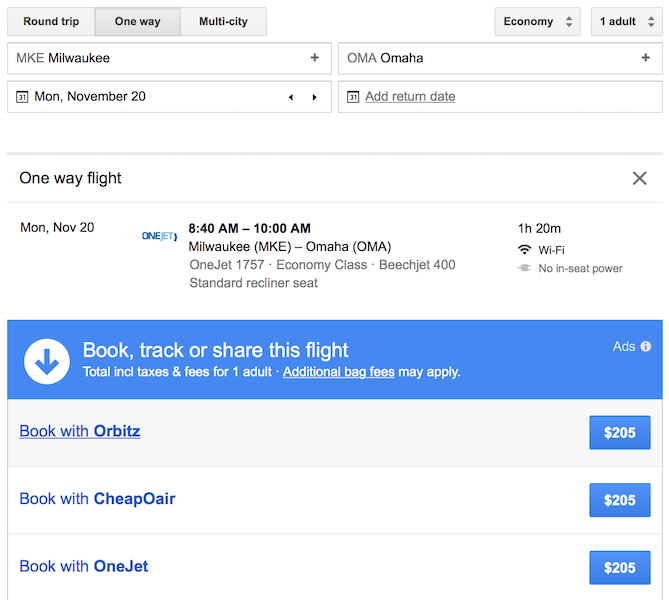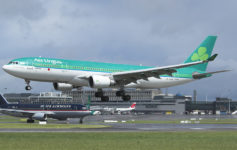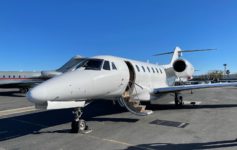OneJet is a new commercial airline operating small private jets based in Pittsburgh. I had the chance to fly their product and loved it but as a travel blogger, I was left with more questions than answers. I reached out to the carrier and the CEO himself made time to talk.
If you are considering booking travel or signing up for a new credit card please click here. Both support LiveAndLetsFly.com.
If you haven’t followed us on Facebook or Instagram, add us today.
Concept
OneJet is a short-haul airline that utilizes 7-8 passenger private jets as commercial flights and sells scheduled routes and individual seats. These aircraft are dedicated for the airline and these are not open leg flights like those that have recently popped up seemingly everywhere. The airline provides direct service to markets that are just far away enough that passengers will avoid driving, but not so far away that OneJet needs long-haul equipment.
The airline flies from regular commercial terminals (not secondary airports or FBOs) and are bookable on OTAs like Google.com/flights.

I covered the flying experience with them last week and I am hoping to fly them again in the near future.
Route Network
The carrier has a simple model to their route network which closely compares to Southwest, RyanAir, Air Asia and EasyJet where they enter a market, establish a base with many flights and reduce their overhead costs on a per flight basis. For example, the monthly cost of an airport ticket counter will be the same whether you run one flight per day or 20 (assuming you could use the same counter for all flights). OneJet would prefer to fully develop cities where many flights can be run and fixed overhead costs can be fully reduced.
Pittsburgh, the carrier’s primary base, is an excellent market case for the business. The city has around 2.4MM people in the metro area but lacks flights to key markets other than hubs from major carriers. OneJet makes their hay on mid-level markets with mostly monopoly routes where prices on other carriers are high, traffic is good, and direct flights are otherwise not an option. The CEO commented on how they choose markets and it makes a lot of sense.
“Low hanging fruit are former medium-sized hubs.” He went on to say that instead of incrementally adding individual routes they add hubs with a “metered approach, focused on expanding on a base-to-base basis.”
It makes an awful lot of sense. I run into Pittsburghers all the time that are surprised they can’t get a direct flight to a city they want to visit. That’s former-hub-syndrome. Looking at the routes, the plan makes sense.
The route I booked was PIT-SDF (Louisville, KY) – a six-hour drive or a one hour flight. American was the most competitive with OneJet on the route, coming in at $401 (I paid $402) but American required a lengthy connection. All told, I would endure a travel time (not counting TSA) that exceeds seven hours. For one dollar more, OneJet got me there direct in an hour – I booked the ticket less than a week prior to departure.
Some of OneJet’s routes compete with other airlines. Nashville-PIT is offered by Southwest, Hartford by American; Delta abandoned PIT-Cincinnati flights but they are always prone to restart a random line. I asked if OneJet was concerned with competing airlines dropping their prices to fill their seats instead of his, and thus starve OneJet out of the market.
“I suppose they could turn on capacity but I don’t think [the other carriers] really see us as competition yet.” Maguire remarked.
I wanted some specifics on how a market like Cincinnati, the shortest drive from Pittsburgh and seemingly, the hardest market, was operating. The Delta Dartboard route selection method puts odd flights all over the place like Indianapolis or Pittsburgh to Paris for example and wasn’t he concerned that Delta could just start a daily back up and kill his route?
“[The] smallest aircraft in the [Delta] mainline system will be 76 seats” A carrier “can’t profitably serve a 30-40 PIDU market with a 76-seat aircraft.” He added that load factors on CVG routes are in the 80th percentile and that “CVG yields are fantastic.” While not specifically naming the route he also disclosed “certain markets we have 96% of the flights selling out.”
When discussing the ability for an airline like Delta to flood the market with cheap seats, he gave me a few reasons why that was unlikely.
There is already an “illogical, irrelevant amount of capacity.” OneJet focuses on “very specific and targeted markets” with a “limited number of seats to fill.”
The kicker is that OneJet only needs 15 origin/destination daily customers (PIDUs) between two markets to make a route that operates near 100% capacity. The airline has cited that there are more than 1,000 such markets in the Northeast US alone. When you start to look around, it doesn’t take long to identify some. The goal for OneJet is to find those mid-size cities without a current hub assignment where the carrier can add 5-8 routes right away.
Not Competing With Other Airlines
OneJet utilizes monopoly routes to big-ish cities that don’t have direct service but do have lots of business connections. When you compare options for traveling business people, one could fly to Chicago a dozen or so times every day on United, American and Southwest and drive 75-90 minutes north to Milwaukee, total travel time in a combination of rental car and flights would be around three hours assuming minimal tarmac time in Chicago. Driving would be an exhausting 8.5 hours and about $30 in tolls or 9 hours with no tolls.
In regards to their target markets Mr. Maguire said “Because of connectivity, they become drive markets.” Coincidentally, another airline CEO Herb Kelleher stated in his famous book, NUTS! that Southwest was competing with driving when they first started out as well. “Up until 3 years ago… Delta had three flights a day on 50-seat [regional jets from Pittsburgh to Cincinnati]. But 40 PIDUs down to two because it’s just inconvenient enough without a direct, so instead of connecting, they drive.”
Drive time is a real factor for busy executives. Here are drive times from Pittsburgh to other metros that OneJet serves:
- Indianapolis 5.5 hours
- Albany 7.5 hours
- Cincinnati 4.5 hours
- Hartford 8 hours
- Louisville 6 hours
- Milwaukee 8.5 hours
- Nashville 9 hours
- Providence 8.5 hours
- Richmond 6 hours
In the case of a road warrior, salesman or business executive, nearly all of these distances burns a day traveling in either direction. Business people driving is inefficient as they are somewhat unavailable during transit and most of these journeys consume the majority of an eight-hour work day. Coming back is the same amount of time and depending on when a customer visit or meeting is to take place, it could force an employee to waste as many as three days for a simple lunch eight hours away.
That’s part of where OneJet shines. The other is of course the product which is sold as economy (this is great for corporate booking engines) and is comparable to first class in almost every way. I reviewed the product previously here.

Economics
I’m a businessman at heart. I enjoyed flying the product but have seen other too good to be true models come and go. When I was growing up, Midwest Express began flying from Omaha as a secondary small hub. It was an all-first class airline flying at coach prices from my home town. It seemed like it would go away – it did – first by transferring to Kansas City and Milwaukee before ultimately the warm chocolate chip cookie crumbled and sold to Republic. It was destined to fail because you simply can’t offer a first class product from a small market for the same price as coach on the other guys.
I was curious, perhaps even suspicious of the business model. After all, Jet A fuel costs more than $5/gallon at my local FBO and a journey of a few hundred miles would run north of $2500 in fuel alone.
I did some simple math.
- I had seen prices on a few of their routes for $200-400/seat depending on how full the flight.
- If all of their flights are on eight seat aircraft, the maximum gross revenue per flight is $3200. After fuel costs alone ($2500) it has to be tough to scrape together a profit when considering maintenance, pilots, ground staff, assuming that 100% of their slots and gates are free (which they of course are not).
I brought this up to Mr. Maguire and asked him to help me understand the math. This is perhaps the most important distinction about the carrier that has led to the success in their model. My cost assumptions were incorrect but for reasons I had not considered possible.
Their model utilizes major airports and they fly in and out of the passenger terminal. Among safety and security benefits in flying from the main terminal, doing so also gives the carrier access to terminal fuel prices. Instead of paying $5+/gallon for Jet A, the terminal is able to pool the massive purchasing volume of all carriers and secure fuel at a cost of “$1.60-1.70 /gallon through the airport fuel market.”
Backing out the differential between private field FBO fuel and gigantic terminal fuel costs would be cut across the board dramatically bringing the “average direct cost on a segment to $700” with average allocated costs “around $500”. And now it all makes a lot more sense.
Subscription Model
I wanted to know about whether or not OneJet was considering a subscription model since just about every new business currently offers one. SurfAir offered the Bay Area to Southern California/LA market airports and over to Las Vegas. Surf then merged with or acquired RISE – a carrier with a similar model operating flights from Houston, Dallas, San Antonio, and Austin, TX. SurfAir features an all-you-can-fly model that runs $1,950/month and could be a great solution if offered by OneJet and if you were based in one of their hubs – but that’s not likely to happen. Maguire broke it down for me and made me feel silly for asking.
“The subscription model is yet to be proven. SurfAir requires markets that are extremely large, what’s comparable to those?”
He’s right. SurfAir essentially fly to most of the populated areas of California, a state with 33 million residents. The Texas market they will soon integrate into their business adds another 18-19 million people into the fold. But he also had enlightened me to a major problem with an all-you-can-fly model:
In order to have capacity and consistency, a carrier has to schedule lots of flights when passengers want to fly (especially Monday mornings and Friday afternoons). You have to offer at least some flights on other days like Wednesdays for some of your customers who don’t need to work a whole week in the other market. For aircraft utilization, you probably have too few for peak times and too many for off-peak. Some customer have trouble booking seats while other days airplanes fly empty.
Loyalty Program
While the CEO makes it clear that “legacy frequent flyer loyalty is a concern” he adds that from a “purely fundamental view… when you have a connection vs. a 45-minute direct flight, you don’t really need a program.”
I really can’t argue with that, though I would still prefer to get something back for my loyalty if I were to fly with them regularly. Maybe something like an empty-seat or empty-leg policy that would let frequent flyers of OneJet hop on flights that weren’t business related after spending a considerable amount of business to the airline.
Irregular Operations (IRROPS)
Following my post last week, some readers had mentioned delays and cancellations they had encountered with the carrier. Thinking back to my own flight, I also had a slight delay. I fly often enough that a slight delay doesn’t really even register for me any more – it could have been weather, tower/traffic delays. But my return was in fact delayed and others had raised concerns about this so I wanted to make sure it was addressed.
Expansion during the summer from just a couple of routes to now more than 180 flights per week from Pittsburgh and the addition of a second base – there were some growing pains. To combat those operational issues, OneJet added spare aircraft to the fleet following the July/August operating months. At any given time there are six OneJet planes in the air and two spares on the ground ready to fill in if an aircraft swap should be required.
They will also add 50 new jobs over the next six months throughout the network, some of which will be additional maintenance and support personnel. Every time a new route opens up there will be growing pains with any carrier, but in fairness to OneJet, their network is smaller, uses more specialized aircraft and faces unique challenges. While I wouldn’t suggest passengers absorb constant delays if the carrier continues to let their customers down, I would state that I certainly see operational delays on the bigger carriers plenty when I fly them. Until it costs me business or becomes so regular and noticeable that I need to find other options, I think the upgrades in service, product and time savings is worth the occasional, limited delay. YMMV.
I thank CEO Matthew Maguire for making himself available to answer questions regarding his operation.
Have you flown OneJet? Are their markets from your home airport that would be an ideal addition for the carrier?




Having covered airlines such as Surf Air in past articles at The Gate, Kyle, one advantage to those other airlines is that passengers may bypass airport security checkpoints because even though larger markets are served, those airlines operate out of smaller airports. To me, that is a potentially major benefit.
Although I have been to the airport in Pittsburgh many times, I am not familiar with any other airports in the Pittsburgh area. Has the leadership team of OneJet considered flights out of smaller airports at Pittsburgh and other destinations to bypass airport security checkpoints to give the airline another competitive advantage while simultaneously delivering potentially faster and easier service to its customers — as well as perhaps an optional transportation service with which they could partner for a seamless travel experience?
Brian, I asked him about this but the issue is the trade between affordability/profitability and terminal inconveniences like passing through TSA instead of avoiding it at the FBO (or even private side of the same airport). Fuel cost would increase approximately four-fold and that would bring seat prices from $200-400/each way to $800-1600/each way. That would make selling seats on a one-hour flight pretty tough and the cost advantage fairly limited. I will gladly go through Pre-check (standard on their bookings) to be able to fly their product – there’s no way my company would pay for flights at $1600-3200 round trip in exchange for a 4-9 hour drive or taking a connection instead.
Kyle, I’m sorry if I am being nitpicky here, but I wanted to make sure you are using the appropriate meaning for the term “direct” flight as opposed to “nonstop” flight.
A nonstop flight is just that – a flight that goes from point A to point B, without stopping
A direct flight will bring you from point A to point B, but may have stop(s) along the way at points C (and potentially D). but is marketed with a single flight number.
I’ve seen multiple people use these phrases interchangeably, so I apologize that you are getting the lecture, but it can be hard to understand what people really mean.
Ever considered that OneJet was a scam? I have 3 friends who invested money and lost quickly.. I am in the business of private jet chartering and told them not to invest. The numbers just didnt’t add up!
Frankly, I had advised others that I was suspect of their pricing in relation to costs which is why specifically asked the question. Having said that, the fuel pool really is a plausible answer to the question.
I think instead the airline fell prey to two issues. First, the carrier had leased the aircraft and reliability and fleet elasticity was consistently an issue. Additionally, the airline expanded too quickly perhaps robbing Peter to pay Paul in the form of subsidies for new routes. From a few direct routes that seemed to be doing well to more than a dozen and an attempted acquisition, all lead to moves that may have been too fast for the airline.
I still think there is something to this model, especially if a carrier focused on traditionally expensive markets that could be served by mid-size private jets or all-premium configured E-135s sitting idly in the desert. Routes that are always over-priced relative to demand and distance like Houston/Dallas to Midland, TX, NYC-Montreal/Toronto, etc. could be the future of an airline like OneJet even if the carrier isn’t able to resurface from their transition period.